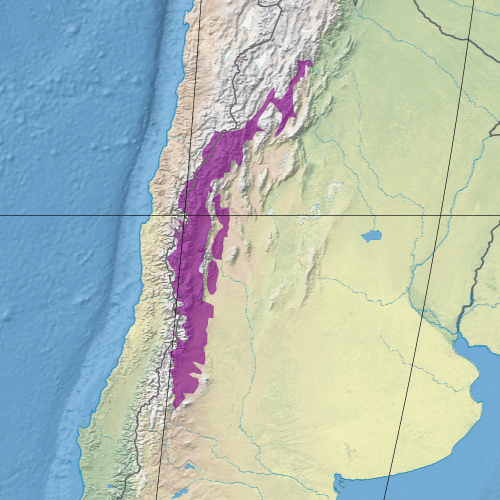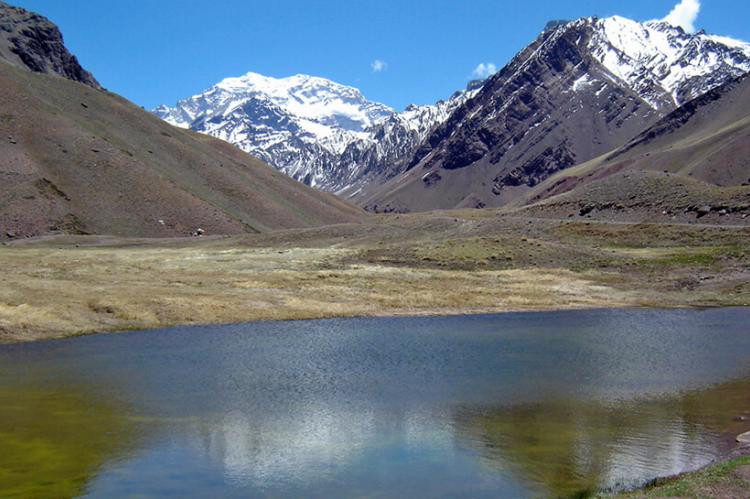The Southern Andean Steppe Ecoregion: A Land of Extremes
The Southern Andean steppe ecoregion in the high-altitude regions of the southern Andes in Chile and Argentina presents a landscape of stark beauty and harsh environmental conditions. This ecoregion is characterized by its cold desert climate, sparse vegetation, and unique biodiversity.
Life at the Edge: Exploring the Southern Andean Steppe Ecoregion
The Southern Andean steppe ecoregion, located in the high-altitude regions of the southern Andes in Chile and Argentina, presents a landscape of stark beauty and harsh environmental conditions. This ecoregion is part of the Montane grasslands and shrublands biome and is characterized by its cold desert climate, sparse vegetation, and unique biodiversity. Despite its seemingly inhospitable conditions, the Southern Andean steppe supports diverse flora and fauna, many of which have remarkably adapted to thrive in this challenging environment.
Geography and Climate
Location and Extent
The Southern Andean steppe ecoregion spans the higher elevations of the Chilean and Argentine Andes, specifically the southern portion of the Andes range. It extends from the high plateaus and slopes at 3,500 to 5,000 meters (11,500 to 16,400 feet) in the north to heights of 1,800 to 3,000 meters (5,900 to 9,800 feet) in the south along the border between Chile and Argentina. The ecoregion is bordered by the Chilean matorral and Valdivian temperate forests to the west, the High Monte to the east, the Central Andean dry puna to the north, and the Patagonian steppe to the south.
Climate
The Southern Andean steppe features a cold desert climate with significant temperature fluctuations and low precipitation. Higher elevations are permanently covered with snow, glaciers, and ice fields. Precipitation in the central and southern parts of the ecoregion primarily comes from Pacific winds and falls mainly in winter, averaging between 200 and 600 mm (8 and 24 inches) annually. In the northeast, precipitation is influenced by Atlantic winds and tends to fall in summer. Temperatures in the higher elevations can vary widely, from a maximum of 19°C (66°F) to a minimum of -25°C (-13°F).
Vegetation and Flora
Adaptations to Harsh Conditions
The vegetation of the Southern Andean steppe is uniquely adapted to withstand the region's harsh climatic conditions and nutrient-poor soils of the region. The flora is characterized by a high degree of endemism and has evolved to cope with the cold, dry, and windy climate. The plant communities are dominated by low-growing shrubs, grasses, and herbaceous plants that can tolerate extreme temperatures, high winds, and low moisture levels.
Key Plant Species
The flora on the western side of the ecoregion can be divided into three zones based on their growth forms and elevation:
- Lower elevations (2,000 - 2,700 m / 6,600 - 8,900 ft): Dominated by large shrubs such as Chuquiraga oppositifolia and Nassauvia axillaris.
- Intermediate elevations (2,700 - 3,300 m / 8,900 - 10,800 ft): Characterized by small shrubs, tussock grasses, and cushion plants, including Azorella madreporica, Laretia acaulis, and Stipa spp.
- Highest elevations (up to 3,900 m / 12,800 ft): Composed of small forbs, rosettes, and grasses such as Nassauvia lagascae, Oxalis erythrorhiza, Nassauvia pinnigera, and Moschopsis leyboldii.
On the eastern side of the ecoregion, vegetation does not grow in distinct zones but includes various species:
- Lower elevations (1,900 - 2,700 m / 6,200 - 8,900 ft): Plants of the genera Stipa, Adesmia, Mulinum, Nassauvia, and Chuquiraga.
- Intermediate elevations (2,700 - 3,300 m / 8,900 - 10,800 ft): Shrubs and cushion plants of Oxalis, Junellia, Adesmia, Laretia, and Azorella.
- Highest elevations (3,300 - 4,500 m / 10,800 - 14,800 ft): Species such as Senecio, Nassauvia, Chaetanthera, Draba, Barneoudia, Leucheria, and Moschopsis.
Fauna and Wildlife
Mammals
The Southern Andean steppe supports a variety of mammal species that have adapted to the region's extreme conditions. Key mammals include:
- Guanaco (Lama guanicoe): A camelid native to South America, the guanaco is well-adapted to the cold, arid conditions of the steppe.
- Puma (Puma concolor): A large predator that hunts various prey, including guanacos and rodents.
- Andean Fox (Lycalopex culpaeus): An adaptable predator that feeds on small mammals, birds, and insects.
- Vicuna (Vicugna vicugna): Another camelid species that grazes on the sparse vegetation of the steppe.
Rodents are also prevalent, including the Andean laucha (Calomys lepidus), Andean mouse (Akodon andinus), mountain vizcacha (Lagidium viscacia), and chinchilla rat (Abrocoma cinera).
Birds
The avifauna of the Southern Andean steppe is diverse, with many species adapted to the high-altitude, open landscapes. Notable bird species include:
- Andean Condor (Vultur gryphus): The world's largest flying bird, known for scavenging carrion.
- Lesser Rhea (Rhea pennata): A flightless bird that inhabits the open plains.
- Magellanic Plover (Pluvianellus socialis): A ground-nesting bird found in wetlands and shorelines.
Other bird species include the ashy sleeper (Muscisaxicola cinereus), black-fronted sleeper (Muscisaxicola frontalis), Andean sebo (Phrygilus gayi), collared snipe (Thinocorus orbignyianus), and Andean hummingbird (Oreotrochilus leucopleurus).
Ecological Significance
Biodiversity
The Southern Andean steppe is an important reservoir of biodiversity, supporting a range of species uniquely adapted to its harsh conditions. The region's plant and animal communities have evolved over millennia to survive in an environment characterized by extreme temperatures, low precipitation, and poor soils. Protecting this biodiversity is crucial for maintaining the ecological balance and resilience of the region.
Conservation Challenges
Despite its ecological significance, the Southern Andean steppe faces several conservation challenges. Habitat loss and fragmentation, driven by agricultural expansion and infrastructure development, threaten the region's biodiversity. Overgrazing by livestock can lead to soil degradation and the loss of native vegetation. Climate change poses additional threats, potentially altering precipitation patterns and exacerbating the impacts of temperature extremes.
Human Presence and Cultural Heritage
Indigenous Communities
The Southern Andean steppe has a long history of human habitation, with Indigenous communities having adapted to the region's challenging environment for thousands of years. These communities have developed unique cultural practices and sustainable land-use strategies that are closely tied to the steppe's natural resources. Preserving this cultural heritage is an important aspect of conservation efforts in the region.
Modern Settlements
Today, the Southern Andean steppe is sparsely populated, with small towns and rural communities scattered across the landscape. These settlements rely on traditional livelihoods, such as livestock herding and subsistence farming, and modern economic activities, including tourism and mining. Balancing economic development with environmental conservation is a crucial challenge for the region's future.
Protection Status
The high elevations and harsh climate of the Southern Andean steppe make it unsuitable for development or farming, resulting in relatively little habitat loss. Several protected areas have been established to conserve the region's unique biodiversity and landscapes, including Laguna del Laja National Park, Nevado Tres Cruces National Park, and San Guillermo National Park.
Conclusion
The Southern Andean steppe ecoregion is a land of extremes, where life has adapted to some of the harshest conditions on the planet. This unique landscape, characterized by its rugged terrain, sparse vegetation, and diverse wildlife, plays a crucial role in southern Argentina and Chile's ecological and cultural heritage of southern Argentina and Chile. Conservation efforts in the Southern Andean steppe must focus on protecting its biodiversity, preserving its cultural heritage, and promoting sustainable development to ensure this remarkable ecoregion continues to thrive for future generations.

Map depicting the location of the Southern Andean steppe (in purple)
